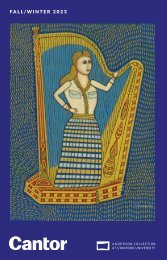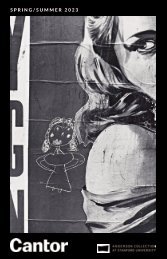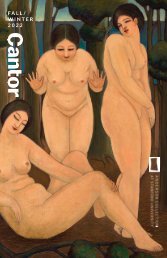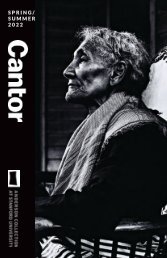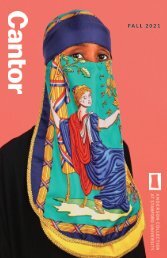A Family Affair
Essays on Modern and Contemporary Art from the Anderson Collection at Stanford University
Essays on Modern and Contemporary Art from the Anderson Collection at Stanford University
You also want an ePaper? Increase the reach of your titles
YUMPU automatically turns print PDFs into web optimized ePapers that Google loves.
MOLLY S. HUTTON<br />
18<br />
appropriate for a campus in which both intellectual pursuits are<br />
highly valued.<br />
STANFORD HOSPITAL<br />
The Andersons’ desire to share their love of art with the community,<br />
evinced through exhibition loans and an active schedule of public<br />
collection tours, is also demonstrated through their involvement<br />
with the Stanford Hospital and Clinics Art Commission. Moo was<br />
one of the original members of the commission, which was established<br />
in 1986 with the goal of bringing contemporary art into the<br />
hospital setting as a way to enrich and humanize the physical<br />
environment for patients, staff, and visitors. “Moo’s presence<br />
brings joy, excitement, and laughter because her love for the arts<br />
is contagious,” says Linda Meier, chair of the art commission,<br />
noting that the hospital’s “reputation for having museum-quality<br />
art” was realized, in no small part, through the dedication and<br />
generosity of Moo. 46<br />
The Andersons had long understood the positive effects of<br />
living with art and of rotating art installations in the workplace;<br />
indeed, this is what Hunk had been doing at Saga for many years—<br />
a practice that continues to this day at the Quadrus complex<br />
offices. To this end, in 1990 they put on long-term loan to the hospital<br />
a group of seventy works of art from their private collection.<br />
In 2001 seventeen of the original group were officially donated to<br />
the hospital. These gifts, says Meier, “strengthen our collection as<br />
well as bring life and awareness to the community.” 47 The hospital<br />
now boasts a diverse collection of contemporary works that hang<br />
throughout its spaces, including on the walls of patient rooms.<br />
Says Moo, who prefers to focus on the affirmative notion of hospitals<br />
as places of healing rather than as places of sickness, “It is<br />
my hope that the artworks installed in the hospital serve as positive<br />
distractions from the anxieties often experienced by those whose<br />
lives necessitate a visit to a medical facility.” 48<br />
“THE PLANTING OF A FRUIT TREE”<br />
“We think of this as only the beginning,” says Hunk of the gift of<br />
the core of the Anderson Collection to Stanford. Liken ing the act<br />
to “the planting of a fruit tree” on campus, the collectors expect<br />
the gift to continue to reward the university community, the Bay<br />
Area, and the public at large for generations to come (fig. 18).<br />
Although “the tree hasn’t started to flower yet,” says Hunk, it is<br />
clear that the positive relationships established over the years<br />
between the Anderson family and its Stanford neighbors ensure<br />
that the tree will soon bear fruit. “My parents constantly instilled<br />
in me the belief that we are only the temporary custodians of the<br />
art in the Anderson Collection,” notes Putter. “I always knew that<br />
Figure 18<br />
The Anderson Collection at Stanford University<br />
(back left) with its neighbor, the Iris & B. Gerald<br />
Cantor Center for Visual Arts (right), April 2014<br />
27




